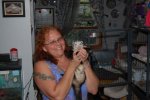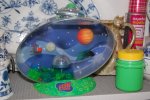michael
2010 Research Grant Donor
- Joined
- Apr 12, 2003
- Messages
- 3,435
- Reaction score
- 175
- Points
- 63
- Location
- Ephrata,Pa
- Country
- United States
- Display Name
- Michael Shrom
A good friend of mine was asking me about the experiments NASA is doing on ribbed newts. I bragged a little about how some of my newts went to outer space. My understanding of the experiments are they are a continuation and coloboration of work originally started by Russian scientists. Some of the work is on tisue regeneration especialy spinal cord, muscle, and bone. Results report to it being faster in outer space. Other work is on viability of offspring and degeneration. I think the work has the potential to be important. Imagine if we could get "people" cells to grow like newt cells do. What could that mean medically?
I've supplied NASA with a few newts from another breeder and mostly with animals I produced myself. The project is ongoing and I think it is worthwhile. I'm not a scientist and don't kow a great deal about the research but from what I've learned I'm enthusiastic about being a part of it.
I've supplied NASA with a few newts from another breeder and mostly with animals I produced myself. The project is ongoing and I think it is worthwhile. I'm not a scientist and don't kow a great deal about the research but from what I've learned I'm enthusiastic about being a part of it.

 Ambystoma Enthusiast
Ambystoma Enthusiast


